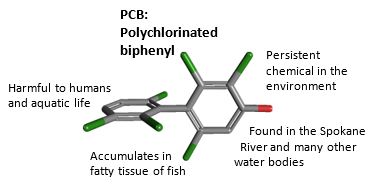What are PCBs?
Polychlorinated biphenyls (PCBs) are a family of toxic human-made compounds that persist in the environment and accumulate in animal tissue. There are 209 different PCB molecules that range in toxicity. PCB mixtures vary, from thin and light-colored liquids to yellow or even black waxy solids.

Background on PCBs
PCBs were first produced in 1927 and became commercially manufactured in 1935 for their insulating and fire resistant properties. They were used in many products including: oil-based paints, hydraulic fluids, electrical equipment (transformers, capacitors, light ballasts, switches, and electromagnets) as well as adhesives and tapes, cable insulation, building caulking, and floor finish. When it was found that PCBs build up in the environment and result in serious health effects in animals and humans:
- Commercial production of PCBs was curtailed in 1977.
- The uncontained use of PCBs was banned in the United States in 1979 via the Toxics Substances Control Act (TSCA).
There were no regulatory controls on PCB disposal before 1979 therefore legacy PCBs can still be found throughout the environment. - In 1979, the estimated global inventory of PCBs was 1.5 million tons.